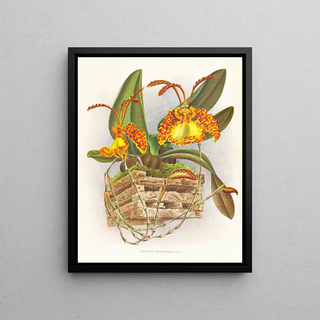Art print | The Murder of the Kramerians - Jean Jules Linden Source: Reproduction | Le meurtre des Krameriens - Jean Jules Linden


View from behind

Frame (optional)
Introduction captivante
Dans l'univers foisonnant de l'art, certaines œuvres se distinguent par leur capacité à capturer des moments dramatiques et poignants. "The Murder of the Kramerians" by Jean Jules Linden is one of these remarkable pieces that, through its visual intensity, manages to evoke deep emotions and provoke reflection. This canvas, rich in details and colors, immerses the viewer in a tragic scene where tension is palpable. By exploring themes of violence and human suffering, Linden invites us to contemplate the repercussions of our actions while immersing us in a captivating visual narrative.
Style and uniqueness of the work
Jean Jules Linden's style is characterized by an impressive mastery of light and shadow, creating an atmosphere that is both dramatic and realistic. In "The Murder of the Kramerians," the composition is carefully orchestrated to guide the viewer's gaze toward the protagonists of this tragic scene. The expressions of the characters, filled with pain and despair, are beautifully rendered, demonstrating the artist's skill in capturing human psychology. The colors, meanwhile, range between dark shades and brighter highlights, emphasizing the contrast between life and death, hope and desolation. This work is not just a visual representation; it is a true narrative unfolding before our eyes, inviting each viewer to question the motivations and consequences of human actions.
The artist and his influence
Jean Jules Linden, a Belgian painter of the 19th century, is often recognized for his exceptional talent in depicting historical scenes and tragic events. His artistic training, enriched by his travels across Europe, allowed him to develop a unique style blending realism and romanticism. Linden was able to capture the essence of his era while drawing inspiration from the great masters who preceded him. His influence extends far beyond his own work, inspiring a generation of artists to explore similar themes of suffering and struggle. Through his works, he managed to give a voice to the oppressed and shed light on social injustices.

Matte finish

View from behind

Frame (optional)
Introduction captivante
Dans l'univers foisonnant de l'art, certaines œuvres se distinguent par leur capacité à capturer des moments dramatiques et poignants. "The Murder of the Kramerians" by Jean Jules Linden is one of these remarkable pieces that, through its visual intensity, manages to evoke deep emotions and provoke reflection. This canvas, rich in details and colors, immerses the viewer in a tragic scene where tension is palpable. By exploring themes of violence and human suffering, Linden invites us to contemplate the repercussions of our actions while immersing us in a captivating visual narrative.
Style and uniqueness of the work
Jean Jules Linden's style is characterized by an impressive mastery of light and shadow, creating an atmosphere that is both dramatic and realistic. In "The Murder of the Kramerians," the composition is carefully orchestrated to guide the viewer's gaze toward the protagonists of this tragic scene. The expressions of the characters, filled with pain and despair, are beautifully rendered, demonstrating the artist's skill in capturing human psychology. The colors, meanwhile, range between dark shades and brighter highlights, emphasizing the contrast between life and death, hope and desolation. This work is not just a visual representation; it is a true narrative unfolding before our eyes, inviting each viewer to question the motivations and consequences of human actions.
The artist and his influence
Jean Jules Linden, a Belgian painter of the 19th century, is often recognized for his exceptional talent in depicting historical scenes and tragic events. His artistic training, enriched by his travels across Europe, allowed him to develop a unique style blending realism and romanticism. Linden was able to capture the essence of his era while drawing inspiration from the great masters who preceded him. His influence extends far beyond his own work, inspiring a generation of artists to explore similar themes of suffering and struggle. Through his works, he managed to give a voice to the oppressed and shed light on social injustices.






